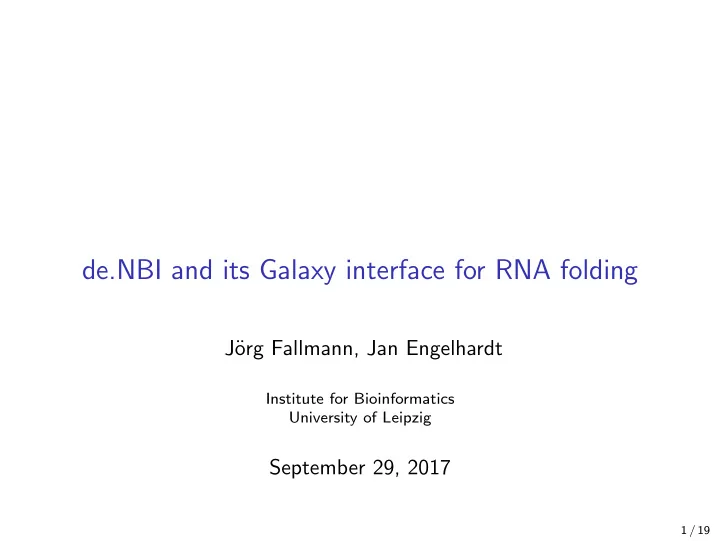

de.NBI and its Galaxy interface for RNA folding J¨ org Fallmann, Jan Engelhardt Institute for Bioinformatics University of Leipzig September 29, 2017 1 / 19
You can download the pdfs you will need today here http://www.bioinf.uni-leipzig.de/ ∼ fall/RNA folding workshop- presentation.pdf http://www.bioinf.uni-leipzig.de/ ∼ fall/Exercises.pdf 1 / 19
Goal : Use RNAfold to do a simple structure prediction. ◮ Upload the file rna.fa into your Galaxy session. ◮ Start RNAfold with standard parameters ◮ Look into the output 2 / 19
◮ CUACGGCGCGGCGCCCUUGGCGA ◮ ........... (((( ... )))) . ( -5.00) 3 / 19
Goal : Use RNAfold to do a structure prediction using the partition function ◮ Start RNAfold using --partfunc ◮ Look into the output 4 / 19
◮ CUACGGCGCGGCGCCCUUGGCGA ◮ MFE: ...........((((...)))). ( -5.00) ◮ PF: .... { , {{ ... |||| ... ) }}} . [ -5.72] The partition function is a rough measure for the well-definedness of the MFE structure. The third line shows a condensed representation of the pair probabilities of each nucleotide, similar to the dot-bracket notation, followed by the ensemble free energy ( − kT ∗ ln ( Z )) in kcal/mol 5 / 19
The partition function allows us to calculate the proportion of a certain structure in the ensemble. Use RNAfold -p to get the ensemble free energy, which is related to the partition function via F = -RT*ln(Q) , for the unconstrained (Fu) and the constrained case (Fc), (use option -C), and evaluate pc = exp((Fu - Fc)RT) to get the desired probability. 6 / 19
◮ CUACGGCGCGGCGCCCUUGGCGA ◮ MFE: ...........((((...)))). ( -5.00) ◮ PF: .... { , {{ ... |||| ... ) }}} . [ -5.72] ◮ CS: ....................... { 0.00 d=4.66 } ◮ MEA: ...... (( ... ))(( ... )) ... { 2.90 MEA=14.79 } ◮ frequency of mfe structure in ensemble 0.311796; ensemble diversity 6.36 Pseudo bracket notation: Here, the usual ’(’, ’)’, ’.’, represent bases with a strong preference (more than 2/3) to pair upstream (with a partner further 3’), pair down-stream, or not pair, respectively. ’’, ’’, and ’,’ are just weaker version of the above and ’ | ’ represents a base that is mostly paired but has pairing partners both upstream and downstream. In this case open and closed brackets need not match up. 7 / 19
8 / 19
Goal : Use SHAPE-directed RNAfold to do a structure prediction ◮ Upload the file rna.simple.shape into your Galaxy session. ◮ Start RNAfold using the shape file and -shapeMethod=D ◮ Look into the output 9 / 19
Goal : Use RNAcofold to predict the cofolding of two sequences. ◮ Upload the file cofold.txt into your Galaxy session. (Look at it) ◮ Start RNAcofold using cofold.txt with the --partfunc option ◮ Look at the output. 10 / 19
◮ GCGCUUCGCCGCGCGCC&GCGCUUCGCCGCGCGCA ◮ ((((..((..((((...&))))..))..))))... (-17.70) ◮ ((((..(,.((((,,.&))))..),.)))),,. [-18.26] ◮ frequency of mfe structure in ensemble 0.401754 , delta G binding= -3.95 11 / 19
Cofold can use concentrations of molecules for duplex prediction, but this is slow for longer sequences. 12 / 19
Goal : Use RNAduplex to predict only intermolecular base pairs of two sequences. ◮ Upload the file duplex.txt into your Galaxy session. (Look at it) ◮ Start RNAduplex using duplex.txt with standard parameter ◮ Look at the output. RNAduplex does not use concentrations and neglects intramolecular interactions, faster but less reliable, good prefilter. 13 / 19
Goal : Use RNAup to test the RNAduplex result. ◮ Start RNAup using duplex.txt with --include both ◮ Look at the output and compare it with the RNAduplex result. RNAup is also taking intramolecular interactions into account. 14 / 19
Goal : Use RNAalifold to predict the consensus structure ◮ Upload the clustal file alifold.aln into your Galaxy session. ◮ Edit the data type of alifold.aln to ’clustal’ ◮ Use RNAalifold with the alifold.aln and --partfunc (Calculate partition function: 1) ◮ (Download the output) and look at it ◮ Bonus : Fold the sequences (alifold.fa) individually (RNAfold) and compare the results. 15 / 19
Goal : Use RNAalifold to predict and visualize the consensus structure ◮ Use RNAalifold with alifold.aln and --color and --aln ◮ (Download the output) and look at it 16 / 19
RNAalifold uses covariance information from sequence alignment to predict a consensus structure. 17 / 19
Goal : Use RNAcode to predict coding sequences in a MAF alignment. ◮ Upload the file oskar.27way.rnacode.maf into your Galaxy session. ◮ (Change its data type to maf) ◮ Use RNAcode with the maf file, --cutoff 0.05, --best region, --best hit, with GTF output ◮ (Download the output) and look at it 18 / 19
Goal : Use RNAz ◮ Upload the file oskar.27way.rnaz.maf into your Galaxy session. ◮ Use RNAz with the maf file ◮ (Download the output) and look at it 19 / 19
Recommend
More recommend